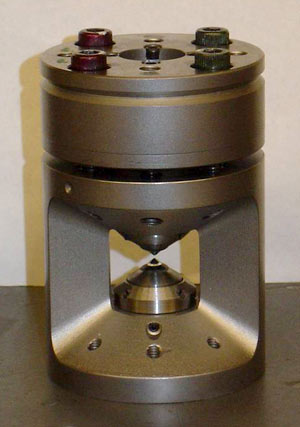High pressure experiments reproduce mineral structures 1,800 miles deep

University of California, Berkeley, and Yale University scientists have recreated the tremendous pressures and high temperatures deep in the Earth to resolve a long-standing puzzle: why some seismic waves travel faster than others through the boundary between the solid mantle and fluid outer core.
Below the earth's crust stretches an approximately 1,800-mile-thick mantle composed mostly of a mineral called magnesium silicate perovskite (MgSiO3). Below this depth, the pressures are so high that perovskite is compressed into a phase known as post-perovskite, which comprises a layer 125 miles thick at the core-mantle boundary. Below that lies the earth's iron-nickel core.
Understanding the physics of post-perovskite, and therefore the physics of the core-mantle boundary, has proven tough because of the difficulty of recreating the extreme pressure and temperature at such depths.
The researchers, led by Yale post-doctoral fellow Lowell Miyagi, a former UC Berkeley graduate student, used a diamond-anvil cell to compress an MgSiO3 glass to nearly 1.4 million times atmospheric pressure and heated it to 3,500 Kelvin (more than 3,000 degrees Celsius, or nearly 6,000 degrees Fahrenheit) to create a tiny rock of post-perovskite. They then further compressed this to 2 million times atmospheric pressure and zapped the substance with an intense X-ray beam from the Advanced Light Source (ALS) at Lawrence Berkeley National Laboratory to obtain a diffraction picture that reveals the deformation behavior of post-perovskite.
They found that the orientation of post-perovskite's crystals in the deformed rock allowed some seismic waves — those polarized parallel to the core-mantle boundary — to travel faster than those polarized perpendicular to it. This anisotropic structure may explain the observations of seismologists using seismic waves to probe the earth's interior.

"For the first time, we can use mineral physics with diamond-anvil cells at the ALS to get information about how this mineral, post-perovskite, performs under intense pressure," said co-author Hans-Rudolf Wenk, a Professor of the Graduate School in UC Berkeley's Department of Earth and Planetary Science and Miyagi's Ph.D. thesis advisor. “People had suggested this as an explanation for the anisotropy, but now we have experimental evidence.”
"Understanding how post-perovskite behaves is a good start to understanding what’s happening near the mantle’s lower reaches," Miyagi said. "We can now begin to interpret flow patterns in this deep layer in the earth."
The study, which appears in the Sept. 24 issue of the journal Science, has important implications for understanding how the earth’s internal heating and cooling processes work.
"This will give seismologists confidence in their models by matching what these observations predict with the seismic data they get," said coauthor Waruntorn "Jane" Kanitpanyacharoen, a UC Berkeley graduate student.
Post-perovskite was first recognized as a high-pressure phase in the mantle in 2004, and subsequent experiments in diamond-anvil cells have produced the mineral. Wenk and his colleagues in 2007 conducted experiments that they thought had determined the deformation behavior of post-perovskite, but which now appear to have been related to the phase transformation to post-perovskite. This transition takes place at about 1,300,000 times atmospheric pressure (127 gigaPascals) and 2,500 Kelvin (4,000 degrees Fahrenheit).
The current experiment showed that post-perovskite's crystal structure is deformed by pressure into a more elongated shape. Because seismic waves travel faster in the stretched direction, this matches the observed difference in velocity between seismic waves polarized horizontally and vertically traveling through the post-perovskite zone above the earth's core.
If scientists can gain a better understanding of the core-mantle boundary’s behavior, it will give them clues as to how Earth’s internal convection works there, where cool tectonic plates descend from the ocean floor through the mantle eventually nearing the dense, liquid-iron outer core, heat up, and begin moving upward again in a repeated cycle that mixes material and heat through the mantle.
Other authors of the paper include UC Berkeley researcher Pamela Kaercher and Kanani K. M. Lee, assistant professor of geology and geophysics at Yale.
The work was funded by the National Science Foundation, with support for the ALS from the U.S. Department of Energy.
